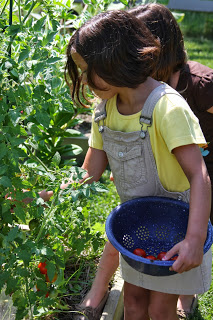 Today, in partnership with National Farm to School month, we celebrate farmers and all of the good food they provide for our schools. But the farm to school partnership can be mutually beneficial—both farmers and schools can offer each other the resources they need to thrive.
Today, in partnership with National Farm to School month, we celebrate farmers and all of the good food they provide for our schools. But the farm to school partnership can be mutually beneficial—both farmers and schools can offer each other the resources they need to thrive.
Below are some ideas for building a strong, synergetic farm to school relationship.
Schools Benefit Farmers
With nearly 12,500 Farm to School programs across the country, schools notably increase the market prospects for local and regional farmers and can offer important income for farm families. Last year, Farm to School programs purchased almost 13 million dollars worth of food from local farms. There are many ways for farmers to get in on this opportunity:
- Sell your products to schools. Start by identifying your school district’s Food Service Director and talk to them about their sourcing policies and capacity to buy directly from you. Be clear about your production capacity, harvest schedule and pricing options.
- Get the word out about your other ventures. Let the school know if you have a CSA or if you sell at a local farmers’ market. If there’s enough interest, consider having a CSA pick up location at the school. Think of other channels where you can advertise your work, like attending a PTA meeting or introducing yourself on the school’s website. These are all great ways to make sure students, parents and employees know about you and the wholesome products you provide the school.
- Don’t forget about other similar partnerships like colleges, universities, hospitals, and local businesses. Leverage your participation in one institution as a way to get your product into another!
Farmers Benefit Schools
Farm to School programs offer kids access to high quality and nutritious foods. As a school, make sure that you’re also tapping into the vast knowledge that farmers can provide.
- Host a Meet Your Farmer day. Invite farmers who contribute to your school’s food programs to speak about what they do; perhaps they can even help plant an edible school garden! Give them an opportunity to share their knowledge of where our food comes from and answer students’ questions. Students will be excited to meet farmers and will likely become more interested in their food as a result.
- Create a photomontage of the farm-to-fork process—from seed to fruit, or cow to cheese! Post photos from participating farms in the school’s cafeteria, and think of creative ways to incorporate food and the farming season into your classroom curriculum.
- Craft a farm fresh menu. Farmers are very in tune with the seasons. Invite them to help your cafeteria staff create seasonally appropriate menus or have farmers write up their favorite ways to cook featured fruits and vegetables throughout the season.
- Take a farm field trip. Deepen your school’s connection with your local farms by taking the classroom on the farm. Use the field trip as a way to give students real-life, hands on experience in food and farming. They’ll love it!
- Compensate fairly. Farming is an incredibly labor-intensive and time-consuming job. We recommend considering thoughtful ways to compensate participating farmers (both financially and otherwise) for any extra time they lend in the classroom or on their farm.
Farm Aid fosters connections between farmers and eaters by growing local and regional food systems and promoting good food from family farms. For more family farmers to thrive, we must expand the reach of good food, including bringing it to schools everywhere. Farm Aid’s Farmer Resource Network helps farmers make these important connections. This online catalog of resources links farmers to valuable organizations — like the National Farm to School Network — that can help them run a smooth and efficient farm to school program. Here are a few additional resources from our Farmer Resource Network partners to check out:
- Community Alliance with Family Farmers has developed a number of resources for farm to school, including this great guide for farmer field trips.
- The Farmer’s Legal Action Group (FLAG) offers comprehensive guides to contracting and marketing, and this tip sheet for selling directly to schools.
- This guide by Vermont Feed includes strategies for marketing local food to schools.
Spread the word about today’s theme and Farm to School Month:
Twitter:
How can farmers benefit schools and schools benefit farmers? Find out on today’s #F2SMonth Theme of the Day page: http://j.mp/FarmerResources
Facebook:
Celebrate both farmers and schools today by learning how the Farm to School partnership can be mutually beneficial! http://j.mp/FarmerResources
Photos above used by permission. © Patty O’Brien



